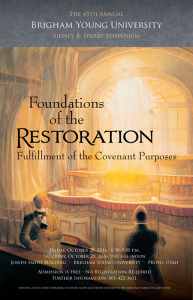Title: Foundations of the Restoration: Fulfillment of the Covenant Purposes
Editors: Craig James Ostler, Michael Hubbard MacKay, Barbara Morgan Gardner
Publisher: Religious Studies Center, BYU, in cooperation with Deseret Book
Genre: Essay collection—proceedings of the 45th Annual Brigham Young University Sidney B. Sperry Symposium
Year of Publication: 2016
Number of Pages: 322 (index begins p. 311)
Binding: Hardcover
ISBN13: 978-1-9443-9407-3
Price: $24.99
Reviewed by Julie J. Nichols for the Association for Mormon Letters
Along with Hugh Nibley and John L. Sorenson, Sidney B. Sperry (1895-1977) legitimized Book of Mormon scholarship in the mid-twentieth century. After his death, his family established a foundation for the continuation of responsible scholarship in Mormon topics; every fall since 1973 BYU Religious Education has hosted an annual symposium, which is “one of the premier venues for Latter-day Saint religious study,” with a wide range of influence through seminars and publications like this volume. (See the Sidney B. Sperry Symposium website at https://rsc.byu.edu/sperrysymposium.)
Each year’s symposium focuses on a specific theme. The 2015 event explored “The Coming Forth of the Book of Mormon,” for example, and in 2014, participants presented on “The Ministry of Peter, the Chief Apostle.” On October 27-28, 2016, the symposium acknowledged a new CES course called “Foundations of the Restoration” (Religion 225, available online). Each of the essays in this collection “[supports] teachers and students as they study and teach key events and doctrines of the Restoration” (vii). Seminary, Institute, and 2016 Gospel Doctrine teachers (D&C and Church History) will especially appreciate the offerings made available here, as many of them directly address topics in the Gospel Doctrine lesson manual. But any student of Church history and evolution will be interested in these well-researched articles.
This is no repository of controversy. The Symposium, and this volume, mean to add clarity, not to present “the philosophies of men, mingled with scripture.” All citations are scriptural, statistical, or from modern-day prophets and apostles and their biographers and transcribers, and all the articles trace the development of some aspect of Restoration doctrine or practice. Historical change is accepted as inevitable. Loyalty to the Restoration is a key point in the first essay in the collection (the keynote speech by Robert L. Millet, professor emeritus of ancient scripture and former dean of Religious Education at BYU). In the same spirit, the second essay, by three BYU assistant professors of Church history and doctrine, carefully defines “doctrine” and establishes that there are core doctrines, beyond which are supporting teachings and policies, as well as hidden esoteric truths that few need to know.
It is suggested that teachers of Church classes apply “careful historical and theological thought to understand the meaning of doctrines past, present, and future, rather than basic acceptance of all declarative statements as being eternally binding” (27). This is commonsense advice, backed by the voice of scholarship and the authority of a BYU Religious Studies venue.
The fifteen essays here (apparently not all the presentations given at the Symposium, but most of them) cover topics such as the role of translation in Joseph Smith’s growth and learning; the Saints’ understanding of the role of a prophet/seer/revelator from the first days of the Church to the present; the Articles of Faith as a framework for understanding the Restoration; Adam-ondi-Ahman; and others.
Three pieces that caught my attention as a Gospel Doctrine teacher were those by Mary Jane Woodger, on the development of the notion of keeping the Sabbath, from Joseph Smith’s time (D&C 59) to the present; Casey Paul Griffiths on the Law of Consecration; and Taunalyn F. Rutherford, on “Evolving Concepts of Zion.” What these three have in common is their attention to the ways that core doctrines have remained while supporting teachings and policies have changed since 1830. An understanding of historical changes, and the sociocultural reasons for them, can be enlightening and comforting for students of the D&C and Church history. That thread—that change is inevitable, but the core doctrines inhere—forms the underlying theme of this volume.
Other essays do the same for the temple and the doctrine of eternal marriage, while articles on two important people in the Restoration picture, Hyrum Smith and William W. Phelps, round out the Table of Contents. This is an attractively-bound, clearly-written assembly of relevant, faithful additions to current Church history materials. It’s well worth the price of purchase.

